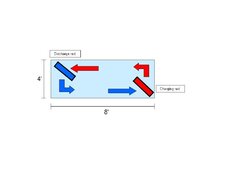Hello everyone, this is my first time to post on this great site.
My wife and I are hoping to build a new home in the near future. I would like to build an energy efficient home that is heated primarily with wood. We currently have a Jotul Castine wood stove that heats our 1700 sq ft home. Although I like our wood stove, I am ready to be done with the dust and smoke inside the house. I am very interested in wood gasification. As I look at different systems, heat storage seems to come up as great way to increase efficiency of gasifier units. I am interested in building non-presurized heat storage space into our next home.
Since I am always trying to find ways to save a buck when possible, I have been pondering economical ways to build heat exchangers. Although various forms of exchangers have been mentioned on this site, I have not seen anything on automotive radiators used as exchangers. Is there a reason for this? I would like to build a box type of tank and a large, truck type brass and copper radiator would fit crosswise in the tank. The Radiator Barn has 1980s Ford 460 truck radiators for $170. I would think that the large finned surface area of a truck radiator would work well as an exchanger. Any thoughts?
My wife and I are hoping to build a new home in the near future. I would like to build an energy efficient home that is heated primarily with wood. We currently have a Jotul Castine wood stove that heats our 1700 sq ft home. Although I like our wood stove, I am ready to be done with the dust and smoke inside the house. I am very interested in wood gasification. As I look at different systems, heat storage seems to come up as great way to increase efficiency of gasifier units. I am interested in building non-presurized heat storage space into our next home.
Since I am always trying to find ways to save a buck when possible, I have been pondering economical ways to build heat exchangers. Although various forms of exchangers have been mentioned on this site, I have not seen anything on automotive radiators used as exchangers. Is there a reason for this? I would like to build a box type of tank and a large, truck type brass and copper radiator would fit crosswise in the tank. The Radiator Barn has 1980s Ford 460 truck radiators for $170. I would think that the large finned surface area of a truck radiator would work well as an exchanger. Any thoughts?


